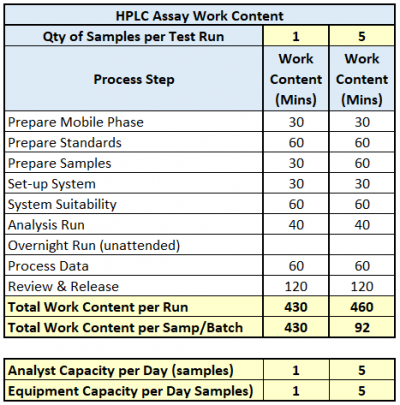Understanding Lean Lab for Operations Excellence Teams
During a lean Lab project, 2 of the questions frequently heard from non-QC stakeholders are:
- Why such a strong focus on workload levelling in QC’s Lean Lab project?
- If it doesn’t take X days to physically test a sample, why does QC need this much lead time?
Operations Excellence teams typically have prior experience of applying lean tools in a production environment, and achieve significant improvements with techniques such as Value Stream Mapping, OEE & TPM, SMED/Changeover improvement, Pull/Kanban, Standard Work, etc.
An effective production operation is typically applying the key lean principle of workload levelling (Heijunka), though they may not consider this to one of their key lean tools. For example, if Production Operation A has a capacity of 5 x batches per week, Scheduling will not plan 2 x batches in Week 1, and 8 in Week 2. Workload levelling is the result of effective capacity management & production scheduling. As a result, and though it is a core lean principle, it is intuitive to most production environments.
In the real world, lab capacity is not a primary (or even secondary) consideration of the production scheduling process. But even if it was, QC Labs are downstream operations, with incoming samples from multiple workstreams – finished product, in process, stability, raw materials, environmental, etc. It would appear inevitable that incoming QC workload will be volatile, and experience tells us that this is invariably the case. To provide the lab with the opportunity to be productive, the most important 1st lean step is to level the lab workload.
Lab capacity is not so readily defined. To quantify, one feature to be considered is the impact of sample grouping. Though the impact varies by test type, the illustration highlights the potential impact of sample grouping using a typical HPLC test run. Whether looking at Analyst work content, or capacity (of Analyst or equipment), the impact is very significant.
QC requires some lead time in order to:
- Level workload within the lab
- Leverage the productivity & capacity benefits of grouping samples on test runs
Of course, service level is a key deliverable in any lean lab project, and the business will not tolerate poor lead time performance in order to deliver benefits elsewhere.
When designing lean lab solutions, a key design target is to be as productive as possible, while delivering consistently against the lead time targets of the business.
Our consultants can provide further information on the above and discuss any aspect of Real Lean Transformation, simply set-up a call today.


